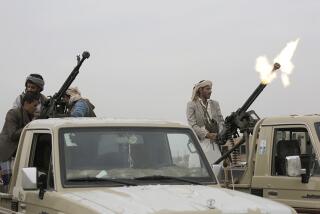Tragedy in the Persian Gulf
- Share via
Iraq owes the United States a speedy and complete explanation of the deadly missile attack Sunday on the American frigate Stark. And the U.S. Navy owes the survivors of the dead crewmen, and the American people, an explanation of why the Stark apparently made no move to defend itself.
The Stark was patrolling in international waters and not the Iraq-Iran war zone, was one comment. Ship’s officers were aware of at least one Iraqi fighter in the area, but Iraqi warplanes had not threatened American ships in the past. In fact, the United States has been attempting to improve relations with Iraq and to restore this country’s claim to “neutrality” in the Persian Gulf conflict.
The Stark apparently attempted to identify itself to the Iraqi aircraft. The Americans certainly would not want to attack an Iraqi fighter without provocation. But why hesitate at firing against incoming missiles, if that was the case?
The Stark was equipped with a rapid-fire Phalanx system to defend against missile attack, and reportedly had 60 to 90 seconds of warning. Perhaps there was some technical reason for not having the Phalanx armed to fire automatically as soon as the missiles were detected. If so, that should be explained.
The attack--accidental or not, in international waters or not--makes it clear that the Persian Gulf is a de facto war zone and American ships operate there at risk.
As Defense Secretary Caspar W. Weinberger noted, American fighting men are in the gulf “not as referees or dispassionate observers,” but to maintain U.S. commitments to allies in the region and to protect shipping from the critical oil fields of the Middle East. And properly so.
At this point, there are more questions about the Stark affair than answers. But it does seem that if the United States is to be an effective peacekeeper in the Middle East, it must first make certain it defends its own forces adequately.
More to Read
Sign up for Essential California
The most important California stories and recommendations in your inbox every morning.
You may occasionally receive promotional content from the Los Angeles Times.









